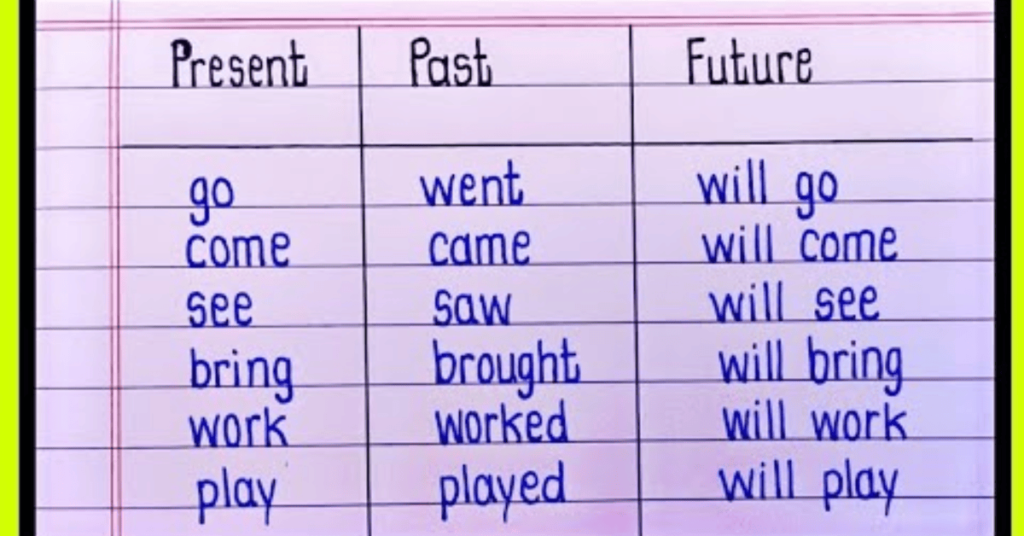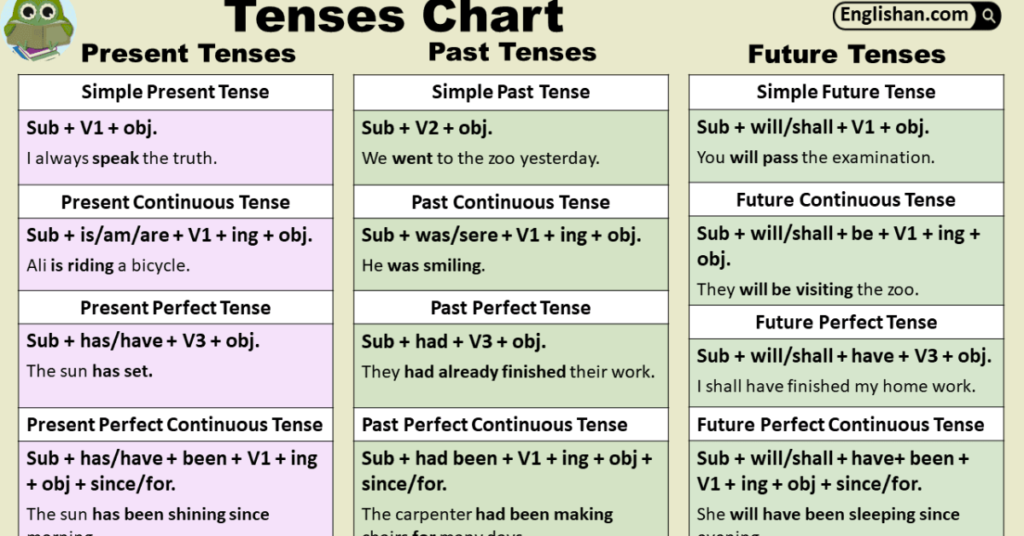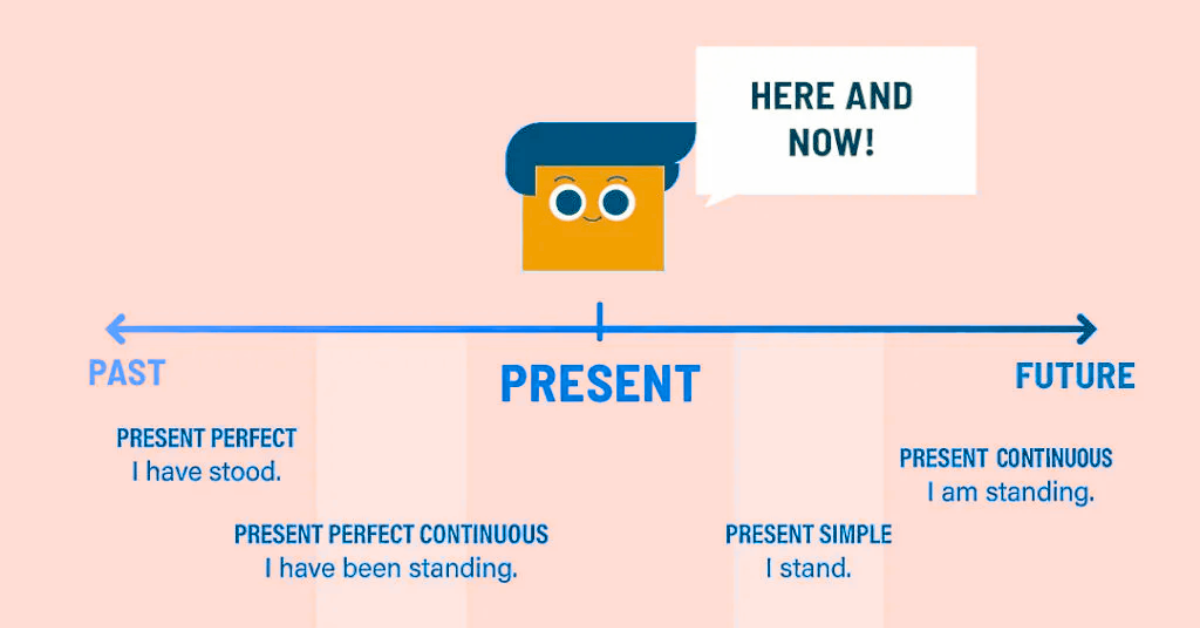One of the most important things to learn when you study English is verb tenses. Verb tenses tell you when an action happens: in the past, present, or future. To communicate well, you need to know how to use past, present, and future tense words correctly. This article will go into great detail about English verb tenses, from the basics to more advanced ideas. It will include examples and explanations for the past, present, and future tenses.
What are the different verb tenses in English?
A verb tense tells us when something happens, like in the past, present, or future. There are three main types of verb tenses: past, present, and future. You can break each of these down into different parts, like simple, progressive, perfect, and perfect progressive. This helps add details, like whether an action is still going on, has been finished, or is still going on.
How many verb tenses are there in English?

English has 12 verb tenses. These tenses help express actions across different times. The number of tenses in English depends on the combination of time (past, present, future) and aspect (simple, perfect, progressive, perfect progressive).
| Tense Category | Tenses |
|---|---|
| Present | Simple Present, Present Continuous, Present Perfect, Present Perfect Continuous |
| Past | Simple Past, Past Continuous, Past Perfect, Past Perfect Continuous |
| Future | Simple Future, Future Continuous, Future Perfect, Future Perfect Continuous |
These tenses give us flexibility in describing actions across different time frames and conditions. Past present future tense words allow speakers to clearly communicate when actions took place, are happening, or will happen.
Why verb tenses are important in communication
Verb tenses are essential in English communication. They help you tell others exactly when something happened or will happen. By using the right verb tenses, you can make your communication clearer, more precise, and more engaging. When you use past tense examples, present tense examples, and future tense examples, you’re providing a full picture of when actions occur.
How to Use Tenses to Avoid Confusion
Using the wrong verb tenses can make things unclear. For instance, “I will went to the store” is wrong because it uses the wrong future tense. The right way to say it is “I will go to the store.” This is why it’s so important to know the right tense rules in English.
Overview of English Verb Tenses
As mentioned earlier, there are three basic verb tenses: past, present, and future. However, these can be further divided into four aspects that help convey different meanings:
- Simple Tense: Expresses basic actions without emphasizing their duration or completion.
- Progressive (Continuous) Tense: Describes ongoing actions.
- Perfect Tense: Describes actions that are completed in relation to another time.
- Perfect Progressive Tense: Describes actions that have been ongoing and are completed at a certain point.
Each of these aspects plays an essential role in forming past present future tense words, making your sentences more precise.
Understanding the Aspect of a Verb
The aspect of a verb adds more detail to the verb tense structure. It shows whether an action is completed, ongoing, or both. Here’s a quick overview of each aspect:
- Simple Tense: Describes basic actions, whether in the past, present, or future.
- Example (Simple Present): I eat breakfast every morning.
- Progressive (Continuous) Tense: Describes actions that are happening right now or were happening in the past.
- Example (Present Continuous): I am eating breakfast right now.
- Perfect Tense: Describes actions that are completed in relation to another point in time.
- Example (Present Perfect): I have eaten breakfast already.
- Perfect Progressive Tense: Describes actions that have been ongoing until a certain point in time.
- Example (Present Perfect Continuous): I have been eating breakfast for 20 minutes.
Understanding these aspects will help you use past present future tense words more accurately.
past present future tense words

Past Tenses
are used to describe actions that have already happened. There are four primary types:
- Simple Past: Action completed in the past.
- Example: She walked to school yesterday.
- Past Continuous: Describes an ongoing action in the past.
- Example: She was walking to school when it started raining.
- Past Perfect: Action completed before another action in the past.
- Example: She had walked to school before the rain started.
- Past Perfect Continuous: Ongoing action that was happening before another past action.
- Example: She had been walking to school for 10 minutes when it started raining.
Present Tenses
Present tenses describe actions happening now or regularly. They include:
- Simple Present: Regular actions or general facts.
- Example: I play tennis every weekend.
- Present Continuous: Actions happening at the moment.
- Example: I am playing tennis right now.
- Present Perfect: Actions that started in the past and are relevant now.
- Example: I have played tennis for 5 years.
- Present Perfect Continuous: Ongoing actions that started in the past and continue to the present.
- Example: I have been playing tennis for two hours.
Future Tenses
Future tenses describe actions that will happen. There are four types:
- Simple Future: Action that will happen in the future.
- Example: I will play tennis tomorrow.
- Future Continuous: Ongoing action that will happen in the future.
- Example: I will be playing tennis at 10 AM tomorrow.
- Future Perfect: Action that will be completed by a certain future time.
- Example: I will have played tennis by noon.
- Future Perfect Continuous: Ongoing action that will continue until a certain future time.
- Example: I will have been playing tennis for two hours by the time you arrive.
12 Tenses Chart in English

Here’s a quick reference chart for the 12 tenses in English:
| Tense | Example | Form |
|---|---|---|
| Simple Present | I eat | Sub + Verb1 |
| Present Continuous | I am eating | Sub + am/is/are + Verb1 + ing |
| Present Perfect | I have eaten | Sub + have/has + Verb3 |
| Present Perfect Continuous | I have been eating | Sub + have/has been + Verb1 + ing |
| Simple Past | I ate | Sub + Verb2 |
| Past Continuous | I was eating | Sub + was/were + Verb1 + ing |
| Past Perfect | I had eaten | Sub + had + Verb3 |
| Past Perfect Continuous | I had been eating | Sub + had been + Verb1 + ing |
| Simple Future | I will eat | Sub + will/shall + Verb1 |
| Future Continuous | I will be eating | Sub + will be + Verb1 + ing |
| Future Perfect | I will have eaten | Sub + will have + Verb3 |
| Future Perfect Continuous | I will have been eating | Sub + will have been + Verb1 + ing |
Examples Sentences Chart of Tenses
Here are more past present future tense words in use with examples:
| Tense | Example Sentence |
|---|---|
| Simple Present | I walk to school every day. |
| Present Continuous | I am walking to school right now. |
| Present Perfect | I have walked to school already. |
| Present Perfect Continuous | I have been walking to school for 30 minutes. |
| Simple Past | I walked to school yesterday. |
| Past Continuous | I was walking to school when it started raining. |
| Past Perfect | I had walked to school before it rained. |
| Past Perfect Continuous | I had been walking to school for 20 minutes when it rained. |
| Simple Future | I will walk to school tomorrow. |
| Future Continuous | I will be walking to school at 8 AM. |
| Future Perfect | I will have walked to school by 9 AM. |
| Future Perfect Continuous | I will have been walking to school for 30 minutes by the time you arrive. |
FAQs
What is a verb tense?
A verb tense shows when an action happens—whether in the past, present, or future.
How many tenses are there in English?
There are 12 tenses in English, including variations like simple, perfect, continuous, and perfect continuous.
What’s the difference between past and present tense?
Past tense refers to actions that have already happened, while present tense refers to actions happening now or regularly.
How do I teach tenses to beginners?
Use simple present tense examples to start. Gradually introduce past tense examples and future tense examples through visual aids and real-life scenarios.
Key Takeaways on Verb Tenses
Mastering past present future tense words is essential for fluency in English. Each tense has specific rules that determine how actions are expressed, making communication more accurate and nuanced. Whether you’re teaching English verb tenses to beginners or trying to perfect your grammar, understanding these tenses is the foundation of great communication.
Final Thoughts on Mastering English Verb Tenses
Understanding past present future tense words helps you become a better communicator. By practicing and applying the tense structures you’ve learned, you’ll gain more confidence and accuracy in both written and spoken English. Keep exploring, practicing, and don’t be afraid to make mistakes—it’s all part of the learning process.
Read More: https://verbohub.com/infront-or-in-front
A passionate linguist and language enthusiast, Mary specializes in the study and teaching of English grammar, helping others master the nuances of syntax and structure. With a keen eye for detail and a love for clear communication, they aim to make grammar accessible and engaging for learners of all levels.

